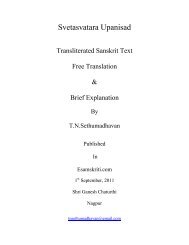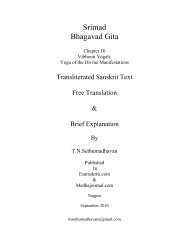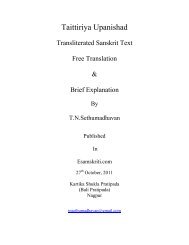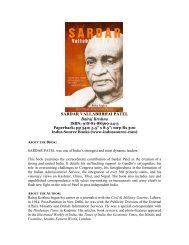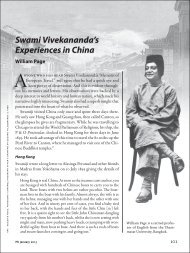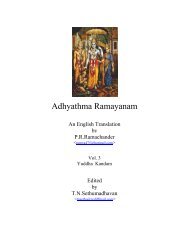SRIMAD BHAGAVAD GITA - Esamskriti.com
SRIMAD BHAGAVAD GITA - Esamskriti.com
SRIMAD BHAGAVAD GITA - Esamskriti.com
- No tags were found...
You also want an ePaper? Increase the reach of your titles
YUMPU automatically turns print PDFs into web optimized ePapers that Google loves.
Frequently asked Questions1. Is the Gita a scripture that propagates war?The answer is that it is concerned neither with violence nor with non-violence. Itneither condones nor condemns war. The point it makes is to look at the root of anyaction. What is the yardstick that makes one war noble and the other ignoble? It is themotivation behind it - is it the ego or the <strong>com</strong>mon welfare based on justice thatdistinguishes the two.Before the battle of Kurukshetra begins, Arjuna asks Krishna to drive their chariotinto the open space between the two armies, so that he may see the men he must fightwith. When Krishna does this, Arjuna recognizes many of his kinsmen and old friendsamong the ranks of the enemy. He is appalled by the realization that he is about to killthose whom he loves better than life itself. In his despair, he exclaims: ‘I will notfight!’Krishna’s reply to Arjuna occupies the rest of the book. It deals not only withArjuna’s immediate personal problem, but with the whole nature of action, themeaning of life, and the aims for which man must struggle here on earth. At the endof their conversation, Arjuna has changed his mind. He is ready to fight. And thebattle begins to fight the evil on the clear understanding that non-resistance to evil isas good as <strong>com</strong>mitting evil.To understand the Gita, we must first consider what it is and what it is not. We mustconsider its setting. Krishna and Arjuna are on a battlefield. Arjuna is not a dedicatedmonk but a householder and a warrior by birth and profession. His problem isconsidered in relation to the circumstances of the moment.In the background of Gita is a war, between two families, ready to start. Arjuna themain hero on one side looks at the family members, elders and friends on the otherside and experiences a strong sense of frustration for infighting in the family.Although he was a great warrior, he merely broke-down by thinking on the utterfutility of this war and in that moment of depression he asks his mentor about what heshould do.The answer given by Shri Krishna is equally unexpected. He says “your presentreluctance to fight is illusion. Your problem is not regarding the fight as such but thefight against what you call my relatives, my brothers, my friends”. Krishna says that“your real fight has to be against ‘I' and 'My’ rather than the fight outside”. It is in thiscontext of how to <strong>com</strong>e out of our ego i.e. ‘ I ‘ and the result of the ego ‘My' that allthe other seventeen chapters have been strung into one garland..In teaching Arjuna, Krishna employs two sets of values, the relative and the absolute.He begins by dealing with Arjuna’s feelings of revulsion, on general grounds. Arjunashrinks from the act of killing. Krishna reminds him that, in the absolute sense, thereis no such act called killing. The Atman, the indwelling Godhead (soul) is the onlyreality. This body is simply an appearance; its existence, its destruction, is likewise,illusory.



